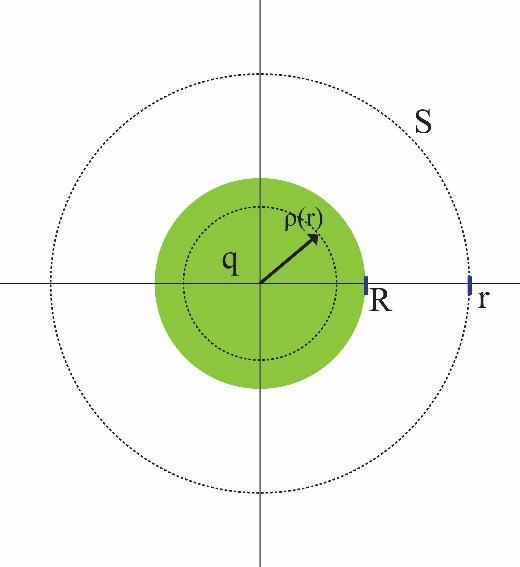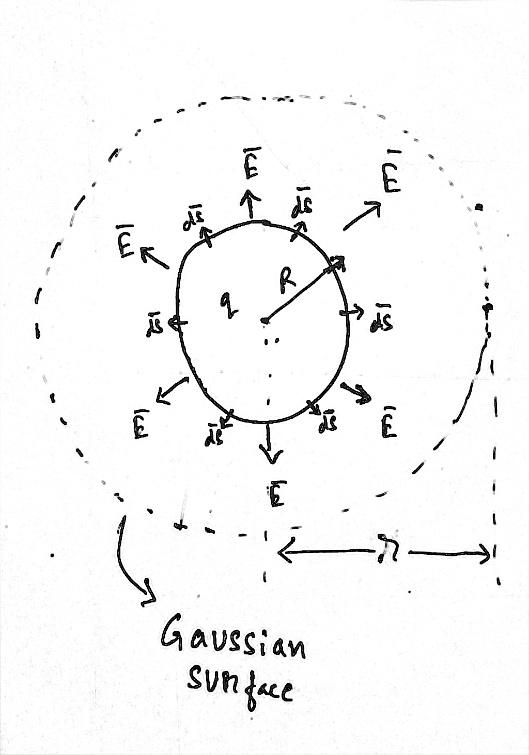
A sphere of radius R has a charge density of $\rho \left( r \right)={{\rho }_{0}}\left( \dfrac{r}{R} \right)$ where ${{\rho }_{0}}$ is a constant and $r$ is the distance from center of the sphere. Find the electric field for $r > R$.
A. $E=\dfrac{{{\rho }_{0}}{{r}^{2}}}{4{{\varepsilon }_{0}}{{R}^{2}}}$
B. \[E=\dfrac{{{\rho }_{0}}R}{2{{\varepsilon }_{0}}}\]
C. $E=\dfrac{{{\rho }_{0}}{{R}^{3}}}{4{{\varepsilon }_{0}}{{r}^{2}}}$
D. $E=\dfrac{4{{\rho }_{0}}{{R}^{3}}}{3{{\varepsilon }_{0}}{{r}^{2}}}$
Answer
586.5k+ views
Hint: Gauss theorem states that the electric flux coming out of a closed surface is equal to $\dfrac{1}{{{\varepsilon }_{0}}}$ times the charge it encloses. Draw a diagram of the charge distribution and apply. Gauss theorem to find the electric field at the given point.
Complete step-by-step answer:
The given charge distribution has density: $\rho \left( r \right)={{\rho }_{0}}\left( \dfrac{r}{R} \right)$
Gauss theorem states that, the electric flux coming out of a closed surface is equal to $\dfrac{1}{{{\varepsilon }_{0}}}$times the charge it encloses. Where ${{\varepsilon }_{0}}$ is electrical permittivity of the material and flux $\phi $ is equal to:
\[\phi =\int\limits_{S}{\vec{E}.d\vec{S}}\]
Where, electric flux is known as the number of field lines perpendicular to a surface area. Therefore, in the equation above: E, the electric field on a given surface S is being used to calculate the flux $\phi $.

Therefore, gauss theorem can mathematically be expressed as:
$\oint\limits_{s}{\vec{E}.d\vec{s}}=\dfrac{q}{{{\varepsilon }_{o}}}$… (1)
q is the total charge enclosed in the closed surface S.
Total charge q in terms of the charge density can be expressed as:
\[q=\int{\rho dV}\]… (2)
Where, $\rho $ is the charge density and V is the volume.
Combining the equation (1) and (2) we have:
\[\oint\limits_{S}{\vec{E}.d\vec{s}}=\dfrac{\int{\rho dV}}{{{\varepsilon }_{o}}}\]… (3)
Now we have to evaluate the above integral.

Since, it is evident from the figure that the surface S is symmetrically placed from the charged sphere. Therefore, the expression simplifies as:
\[\phi =\int\limits_{S}{\vec{E}.d\vec{S}}=\left| {\vec{E}} \right|\int\limits_{S}{\left| d\vec{s} \right|}=4\pi {{r}^{2}}E\]… (4)
As the area of the surface S is $4\pi {{r}^{2}}$.
Evaluating the total charge:
\[\begin{align}
& q=\int{\rho dV} \\
& q=\iiint\limits_{V}{\dfrac{{{\rho }_{0}}}{R}r\times dV} \\
& q=\iiint\limits_{V}{\dfrac{{{\rho }_{0}}}{R}r\times {{r}^{2}}\sin \theta drd\theta d\varphi } \\
\end{align}\]
Where $\theta $ and $\varphi $ are azimuthal angles.
\[\int\limits_{\theta =0}^{\pi }{\sin \theta d\theta }=2\]
\[\int\limits_{\varphi =0}^{2\pi }{d\varphi }=2\pi \]
The total charge comes out to be:
\[\begin{align}
& q=\dfrac{4\pi {{\rho }_{0}}}{R}\int\limits_{r=0}^{R}{{{r}^{3}}dr} \\
& q=\dfrac{4\pi {{\rho }_{0}}}{R}\dfrac{{{R}^{4}}}{4} \\
& q=4\pi {{\rho }_{0}}\dfrac{{{R}^{3}}}{4} \\
\end{align}\]
Evaluating the Gaussian surface integration, from equation (3) and (4), we have,
$\begin{align}
& \oint\limits_{S}{\vec{E}.d\vec{s}}=\dfrac{q}{{{\varepsilon }_{o}}} \\
& 4\pi {{r}^{2}}\times E=\pi {{\rho }_{0}}\dfrac{{{R}^{3}}}{{{\varepsilon }_{o}}} \\
& \text{That is,} \\
& E=\dfrac{{{\rho }_{0}}{{R}^{3}}}{4{{\varepsilon }_{0}}{{r}^{2}}} \\
\end{align}$
Thus, option C is the correct answer.
NOTE: We are allowed to use gauss theorem for all the charge distributions; it is not compulsory for them to be symmetric. But one should be careful while calculating the flux. That is only when the charge distribution is symmetrical, will the electric field term E and the surface area $4\pi {{r}^{2}}$ will come out of the integration independently.
Complete step-by-step answer:
The given charge distribution has density: $\rho \left( r \right)={{\rho }_{0}}\left( \dfrac{r}{R} \right)$
Gauss theorem states that, the electric flux coming out of a closed surface is equal to $\dfrac{1}{{{\varepsilon }_{0}}}$times the charge it encloses. Where ${{\varepsilon }_{0}}$ is electrical permittivity of the material and flux $\phi $ is equal to:
\[\phi =\int\limits_{S}{\vec{E}.d\vec{S}}\]
Where, electric flux is known as the number of field lines perpendicular to a surface area. Therefore, in the equation above: E, the electric field on a given surface S is being used to calculate the flux $\phi $.

Therefore, gauss theorem can mathematically be expressed as:
$\oint\limits_{s}{\vec{E}.d\vec{s}}=\dfrac{q}{{{\varepsilon }_{o}}}$… (1)
q is the total charge enclosed in the closed surface S.
Total charge q in terms of the charge density can be expressed as:
\[q=\int{\rho dV}\]… (2)
Where, $\rho $ is the charge density and V is the volume.
Combining the equation (1) and (2) we have:
\[\oint\limits_{S}{\vec{E}.d\vec{s}}=\dfrac{\int{\rho dV}}{{{\varepsilon }_{o}}}\]… (3)
Now we have to evaluate the above integral.

Since, it is evident from the figure that the surface S is symmetrically placed from the charged sphere. Therefore, the expression simplifies as:
\[\phi =\int\limits_{S}{\vec{E}.d\vec{S}}=\left| {\vec{E}} \right|\int\limits_{S}{\left| d\vec{s} \right|}=4\pi {{r}^{2}}E\]… (4)
As the area of the surface S is $4\pi {{r}^{2}}$.
Evaluating the total charge:
\[\begin{align}
& q=\int{\rho dV} \\
& q=\iiint\limits_{V}{\dfrac{{{\rho }_{0}}}{R}r\times dV} \\
& q=\iiint\limits_{V}{\dfrac{{{\rho }_{0}}}{R}r\times {{r}^{2}}\sin \theta drd\theta d\varphi } \\
\end{align}\]
Where $\theta $ and $\varphi $ are azimuthal angles.
\[\int\limits_{\theta =0}^{\pi }{\sin \theta d\theta }=2\]
\[\int\limits_{\varphi =0}^{2\pi }{d\varphi }=2\pi \]
The total charge comes out to be:
\[\begin{align}
& q=\dfrac{4\pi {{\rho }_{0}}}{R}\int\limits_{r=0}^{R}{{{r}^{3}}dr} \\
& q=\dfrac{4\pi {{\rho }_{0}}}{R}\dfrac{{{R}^{4}}}{4} \\
& q=4\pi {{\rho }_{0}}\dfrac{{{R}^{3}}}{4} \\
\end{align}\]
Evaluating the Gaussian surface integration, from equation (3) and (4), we have,
$\begin{align}
& \oint\limits_{S}{\vec{E}.d\vec{s}}=\dfrac{q}{{{\varepsilon }_{o}}} \\
& 4\pi {{r}^{2}}\times E=\pi {{\rho }_{0}}\dfrac{{{R}^{3}}}{{{\varepsilon }_{o}}} \\
& \text{That is,} \\
& E=\dfrac{{{\rho }_{0}}{{R}^{3}}}{4{{\varepsilon }_{0}}{{r}^{2}}} \\
\end{align}$
Thus, option C is the correct answer.
NOTE: We are allowed to use gauss theorem for all the charge distributions; it is not compulsory for them to be symmetric. But one should be careful while calculating the flux. That is only when the charge distribution is symmetrical, will the electric field term E and the surface area $4\pi {{r}^{2}}$ will come out of the integration independently.
Recently Updated Pages
A man running at a speed 5 ms is viewed in the side class 12 physics CBSE

The number of solutions in x in 02pi for which sqrt class 12 maths CBSE

State and explain Hardy Weinbergs Principle class 12 biology CBSE

Write any two methods of preparation of phenol Give class 12 chemistry CBSE

Which of the following statements is wrong a Amnion class 12 biology CBSE

Differentiate between action potential and resting class 12 biology CBSE

Trending doubts
What are the major means of transport Explain each class 12 social science CBSE

Which are the Top 10 Largest Countries of the World?

Draw a labelled sketch of the human eye class 12 physics CBSE

How much time does it take to bleed after eating p class 12 biology CBSE

Explain sex determination in humans with line diag class 12 biology CBSE

Explain sex determination in humans with the help of class 12 biology CBSE




